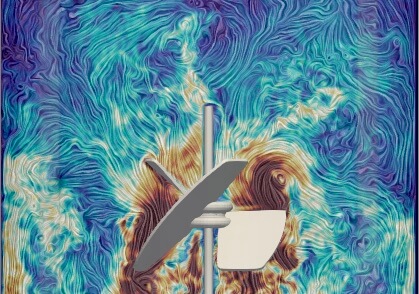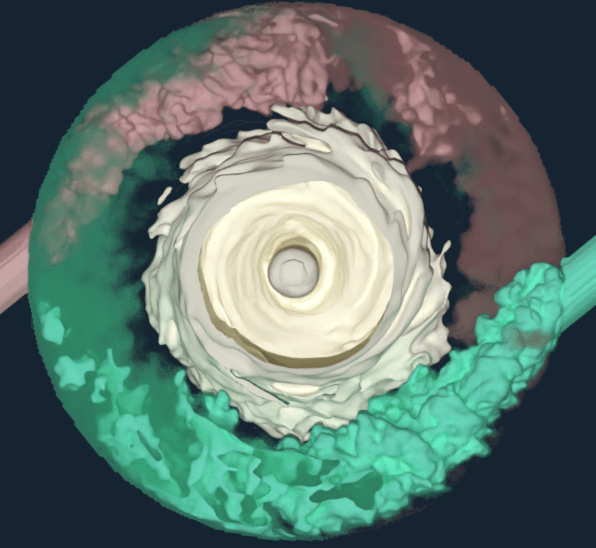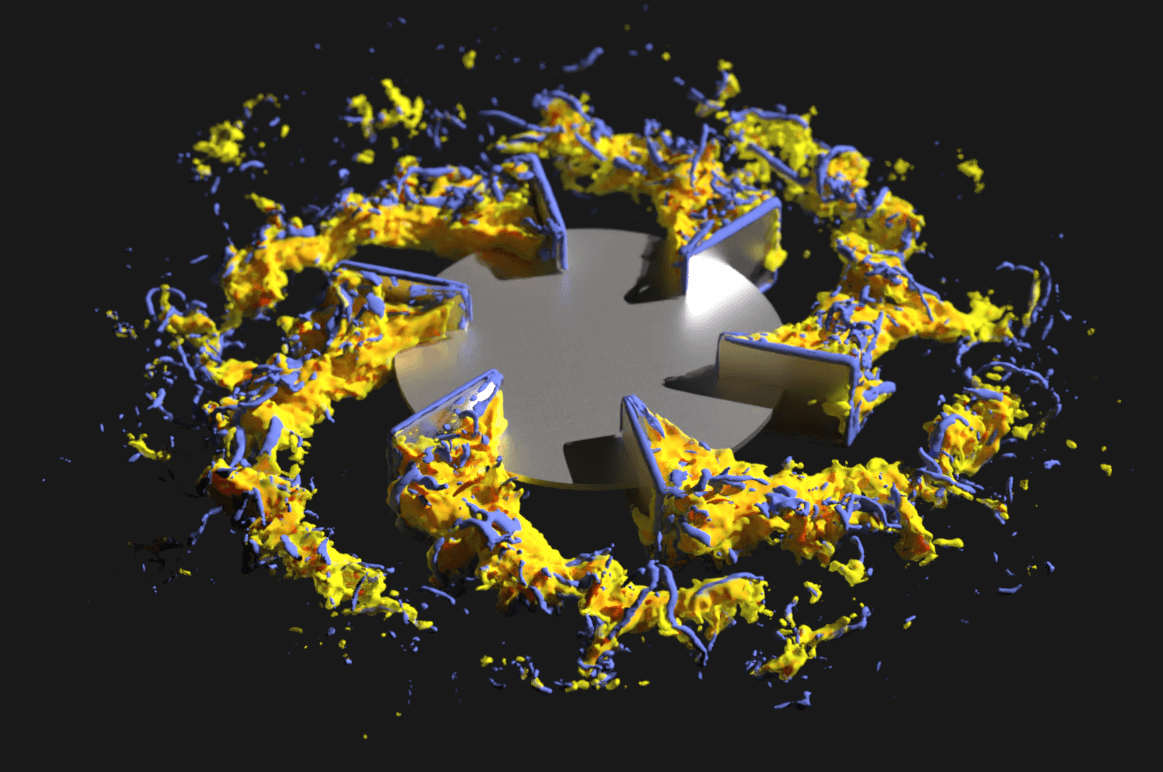This week, guest Johannes Wutz from M-Star Center Europe GmbH joins John to discuss turbulence modeling.
“If I have to resort to a RANS simulation, I better get ready to cook up some alphabet soup because I’m going to need to parameterize the heck out of this thing to account for the missing physics that are not captured by these approaches.”
– John Thomas
In this episode, John and Johannes answer the questions:
- What is a turbulence model?
- What is RANS and why is it so common?
- What are the alternatives?
- What are the industrial implications of better turbulence modeling?
John Thomas: Hi, everybody. Thanks for joining us today. Today we’re talking about turbulence modeling and a little bit about RANS, a little bit about LES, and a little bit about DNS.
And to help guide today’s discussion, I’ve invited Johannes Wutz from M-Star Center Europe GmbH to join us and talk about his experience of turbulence modeling and some of the new paradigms we have available to us and the industrial implications. Johannes, thanks so much for being here.
Johannes Wutz: Thanks, John.
John Thomas: You’re calling in from Germany, so I appreciate you taking time out of your day. So you work with us here at M-Star doing software development and code validation and client support. How did you get to today? Tell me a bit about your background in terms of engineering, computational physics and CFD.
Johannes Wutz: So I wrote my PhD thesis in Stuttgart, you know it was about bioprocess engineering. It was CFD and AI models like stirred tank bioreactors for the pharmaceutical industry. And when I was finished, you know, they liked my work, they liked me, so I went into our industry partner, into their company, and there I worked for roughly five to six years. And yeah, I mean, it is a European company, so I have never heard of M-Star before until one of our clients actually used it, you know, and he got much better results than we did with our approaches. And well, you know, the rest of the story – so I contacted you, we started the trial and I was immediately hooked. And yeah, I loved it from the beginning.
John Thomas: It’s a good story. It’s a good story. So, so how did you first hear about CFD? Like when did you as a young man first become aware of these modeling concepts and modeling paradigms?
Johannes Wutz: Well, I first heard about it during my studies of like this bioengineering study thing, and I love the visualization aspect of it as well because you have these physics and they just look so great and you can get so much out of it. It’s so much more than pure numbers.
John Thomas: Yeah. You know, I see that as a recurring theme is that sometimes I think in modeling, people get caricatured as being very number focused and looking only at spreadsheets or whatnot. But a lot of us got in this field because we love the visual aspect, right? And be able to see and render really complicated transport phenomena on a screen. It’s really satisfying to me, at least, and it seems to be a recurring theme with other modelers as well.
Johannes Wutz: Yeah, exactly.
John Thomas: And so you started running simulation in grad school, sounds like?
Johannes Wutz: Yes.
John Thomas: So almost every discussion of CFD begins with some discussion of turbulence modeling. Now, this might not be relevant for laminar systems, but for any sort of transitional and turbulent flow, people usually start talking about how they’re handling turbulence. Johannes, what’s a turbulence model?
Johannes Wutz: Well, you know, in an ideal world, we wouldn’t actually need turbulence models. If we had extreme computational power, which we might have in, I don’t know, 100 years or whatever, then we could resolve every flow structure. So, you know, turbulence is kind of this energy cascade through the inertial range into dissipation range. And when you do direct numerical simulation, you resolve everything. But that’s not practical, of course. Maybe you can do it for very small systems, but in industrial relevant applications, you need some kind of turbulence modeling, which means you don’t resolve the small structures, but you model them with different approaches.
John Thomas: Got it! So I hear different terms discussed. There’s RANS, there’s LES. What are these different flavors of turbulence models? Are they all the same or are some more detailed than others?
Johannes Wutz: So RANS models are very common, and that has different reasons we will talk about later. The basic principle is that, you know, there is some time averaging of the velocity fluctuations, which you don’t resolve, and you derive equations for that and then you try to close this problem with different modeling approaches, like K Epsilon, K Omega, those types of models.
John Thomas: Got it. So you’ve kind of talked about two ends of the spectrum here. You talked about direct numerical simulation where you’re trying to capture everything. And that requires a very high resolution and may only be relevant to small systems, at least that are fully turbulent.
Then to the other end of the spectrum, it sounds like, well, we just throw our hands in the air and say, you know what? Let’s just forget about even trying to model the transient behavior explicitly. Let’s just stuff it all into some sort of parameterized, turbulence closure model, which is RANS? OK, so I like simple models. Are there limitations associated with this kind of time-averaged, stuff it all into a closure model approach?
Johannes Wutz: Yeah. And I wouldn’t call them simple at all. You know, they are very, very complex. And some it’s like two or maybe one additional partial differential equation and they are coupled. And, you know, it’s really hard to understand them and to get a feeling for them.
So, yeah, I mean, the limitation is obviously that they are inherently intransient.
John Thomas: That’s a stark point.
Johannes Wutz: Yeah.
John Thomas: We’re combining intransient turbulence models with inherently transient processes.
Johannes Wutz: Yeah, exactly. I mean, you can do transient simulations based on these models, but that’s kind of contradictory, right? And from my experience, the results are not that great when it comes to transient stuff like blending, you know, which is kind of obvious.
John Thomas: But yeah, it’s kind of as you unpack the acronym, I can see how you kind of undress the emperor. It’s like, OK, we’re using time-averaged flow fields to model a transient transport process. It just seems like, as you say it out loud, it kind of starts to make a lot of sense.
That point you made about parameterization was interesting. And so at one end of the spectrum, we have direct numerical simulation. Are there any parameters, any sort of knobs or parameters we need to specify in direct numerical simulation? Because you mentioned that RANS had a lot. Does DNS, direct numerical simulation, have any?
Johannes Wutz: No, it doesn’t have any. Because, as I said, you are resolving everything. You know, the physics, everything is determined.
John Thomas: You know, that’s an interesting theme here. The more physics you resolve explicitly, the fewer you’re trying to model semi-empirically. Said, again, it’s like this it seems like: The less we’re capturing in our simulation directly, the more complex and parameterized our model becomes it seems like. If I have to resort to a RANS simulation, I better get ready to cook up some alphabet soup because I’m going to need to parameterize the heck out of this thing to account for the missing physics that are not captured by these approaches.
Johannes Wutz: Yep.
John Thomas: But the strengths are at least that makes a problem tractable, right? If DNS, direct numerical simulation, isn’t tractable, at least RANS makes a problem tractable on a computer sounds like.
Johannes Wutz: Yeah, exactly.
John Thomas: Which is why it’s common, I imagine.
Johannes Wutz: Yeah, that’s one of the reasons. You can do it with little resources. And you know, that’s an aspect you shouldn’t forget. It’s also about, let’s say, tradition. You know, there’s so much literature out there about RANS modeling and people build different physics on top of these models. So when you start CFD, you are of course scared to use something that’s not cited like 100 times, right?
John Thomas: [Laughs] Yeah.
Johannes Wutz: So that’s also a big factor, I think.
John Thomas: I think that’s true as we just kind of … you know, there was a saying in the eighties that went: No one ever got fired for buying IBM. What it meant is that, you know what, just do what the guy before you did and you’ll be OK.
I think that could be applied today. No one ever got fired for using RANS. They might not have learned anything, but they certainly won’t get fired.
Johannes Wutz: Exactly.
Let’s talk about other approaches. I mean, so we talked about RANS. We talked about direct numerical simulation. Is there anything in the middle?
Johannes Wutz: Yeah, that would be LES, large eddy simulation. You need higher resolution than you would for RANS models, but it’s a very, very simple model. It’s just a low pass filter on the Navier-Stokes equations. It’s the same concept in the way that it is an eddy viscosity model, which is an interesting concept. You know, the small turbulence structures are kind of perceived as a higher viscosity, and that’s what many of these models are based on.
John Thomas: You mentioned simpler. Does this mean fewer tuning parameters and knobs?
Johannes Wutz: Yeah, it actually only has one, let’s say, tuning parameter, but it’s not really a tuning parameter since it was derived from a simulation. So it is a closed kind of thing.
John Thomas: That’s neat. So I’m not kind of massaging that each time I run a simulation. Is LES transient?
Johannes Wutz: Yes, of course. Yeah.
John Thomas: So it’s kind of closer to the DNS side of things than it is the time-averaged side of things in that it’s modeling transient fluid flow and transport physics.
Johannes Wutz: Exactly. I mean, you can do DNS without turning off the LES filter. Then it just, it just plays no role. But there is a smooth transition, and that’s one of the main strengths. So for other RANS models like K Epsilon, for example, you need to make sure that you are in a fully turbulent regime and you don’t need this assumption for LES. You can just simulate the complete spectrum without having to worry about your problem.
John Thomas: Yeah, I’ve seen that too, and that we can go from Reynolds numbers of one to 1,000,000 using a single – without any reparameterization of the closure model. And that’s pretty cool because it means that we’re not, how should I put this, just in the recipe, depending on the flow physics trying to see.
Johannes Wutz: Exactly.
John Thomas: So LES sounds like a really promising middle ground here. Why is it not the standard? Why do people jump to these highly parametric, semi-empirical RANS models?
Johannes Wutz: Well, because it’s more expensive numerically, and with standard finite volume approaches, you really need a cluster to run LES for industrial applications. But you know, that’s different with lattice-Boltzmann since we have this high resolution and the small time steps we can use LES.
John Thomas: Got it. So because we’re able to use a fully transient algorithm and it has appropriate resolution and timestamp, we can evoke a better turbulence model.
Johannes Wutz: Yeah, exactly. And lattice-Boltzmann is an explicit, transient method, so it just fits well.
John Thomas: Yeah, it does go hand in glove. I would say that very few finite volume-based codes even attempt to do LES for the reasons you’re describing within the context of industrial setting. It’s just not practical. And as a consequence, there are a lot of… there’s a lot of parameterization, but not a lot of generality of those modeling results.
Johannes Wutz: Yeah.
John Thomas: Okay, Johannes. So what makes M-Star so special? Why is M-Star going straight for the jugular in terms of better turbulence modeling? How is it able to run competitively with these more precise turbulence models that demand higher resolutions and smaller timestamps? How was able to compete with a RANS-based CPU solver?
Johannes Wutz: Well, that’s because it was designed to run on GPUs and, well, you know, the recent GPU hype, it’s there for a good reason because they are just – when you have the right algorithm, they are just a lot faster than CPUs, so you can speed up your simulation by orders of magnitude and therefore like run minutes of wall time without any problems.
John Thomas: Got it! So this pivot to GPU-based computing allows us to run higher fidelity simulations faster.
Johannes Wutz: Exactly, exactly. That became very relevant during my time in the industry because with RANS modeling, to be honest, I wasn’t too confident in my own results because it was – we just had this huge trade-off this intransient model, but we were always trying to find solutions for inherently transient problems and that kind of got solved. So, you know, I got extremely more confident in my results and I could generate a lot more in less time, and it was a lot more reliable in my experience.
John Thomas: Using these GPU-based, LES simulations.
Johannes Wutz: Exactly. Yeah.
John Thomas: Yeah. Got it. That’s pretty cool. That’s what I’m seeing as well. OK, Johannes, this is great information. Where do folks go for here if they want to start to learn more about these better turbulence modeling paradigms and better modeling frameworks? Where do they go? What should they read? How should they begin their study?
Johannes Wutz: Well, I mean, there’s a lot of literature, very good literature out there. There’s lots of great YouTube videos and stuff like that.
John Thomas: Mm-Hmm.
Johannes Wutz: But the best way, really? Just try it. Yeah. Get on and start a trial. Look at the code, run it and you will see for yourself.
John Thomas: I think that’s fair, and I think that was your experience is that once you kind of do it, once you start running with the superior model paradigms….
Johannes Wutz: You can’t go back.
John Thomas: You can’t go back. That’s what I’ve seen as well. Johannes, this was great. Thanks so much. I know that we’re working between time zones here. I know that you have a lot going on, so I really appreciate you taking time to borrow some of your expertise and some of your familiarity.
Johannes Wutz: Yeah, no problem. Thank you.
 Explore the Scientific R&D Software
Explore the Scientific R&D Software 


















